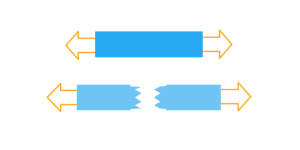Elongation Properties of Parylene
Posted by Sean Horn
Friday, September 7, 2018 3:04
@ 3:04 PM
For conformal coatings, elongation is a measure of material ductility — a specific coating’s ability to undergo significant plastic deformation before rupture. A coating’s yield elongation is the maximum stress the material will sustain before fracture. Thus, computed parylene (XY) elongation measurements represent the total quantity of strain the conformal film can withstand before failure. While elongation is equal to a material’s operating failure strain, it has no exclusive units of measurements. Typically,
- it is represented as % strain,
- or percent area reduction from a tensile test, equaling
- the ratio between the affected material’s physical change (deformation) and the original length,
- generally defined as the change in length divided by the initial length.
The result is a figure for material elongation expressed as a percentage (%), showing how much bigger the object is after deformation has completed. Signified by the Greek letter ε, strain measures a material’s deformation/extension when subjected to a force or set of forces. Five percent (5%) elongation is considered significant; conformal coating needs to withstand that level and more for reliable, ongoing performance.
Annealing promotes elongation. It removes a coating’s internal stresses by heating the material, followed by slow-cooling. In annealing, atoms migrate in the crystal lattice, lowering the quantity of dislocations, while altering coating ductility; the coating recrystallizes as it cools, increasing ductility.
Tensile testing is often used to determine elongation at break. Synthetic polymer materials generally show enhanced ductility; this is true for parylene, widely used for conformal coatings, protecting performance of printed circuit boards (PCBs) and related electronics within a wide range of uses. XY typically records high levels of elongation to failure, imperative for dependable conformal film protection.

Using a chemical vapor deposition (CVD) application process, one of parylene’s major advantages is room-temperature deposit and cure; unlike liquid coatings – resins of acrylic, epoxy, silicone and urethane — it requires no separate curing procedure. This factor also bypasses the substantial temperature excursion associated with liquid conformal films. Implemented in a vacuum chamber, CVD generates inherently cleaner film application.
Tests of parylene’s elongation capabilities have provided a variety of generally positive results, especially in comparison to liquid coatings:
- Considering fundamental components of elongation performance, a recent study of parylene C’s barrier properties measured its elongation to break @ 200%, with a yield elongation of % = 2·9 3. Thus, parylene can elongate thrice its original size before breaking (the original length [100%] + twice more [200%] = three times longer). In addition, this study registered parylene’s yield strength — the quantity of stress corresponding to a coating’s specified permanent plastic deformation — @ 5·52 x 107n1m2. Parylene C’s tensile strength was 6·90 x 107n1m2, in this report, evidence corroborated by an additional study.
- A third study tested for improved parylene C biocompatibility. During CVD application of thin parylene C films, different deposition pressures were used to produce conformal films at 5 μm. When increasing either deposition rate or pressure, elongation capacities diminished, while tensile strength increased, evidence supported by studies four and five.
- A fourth study tested parylene C adhesion on a variety of metallic and polymide substrate materials. Reliable adhesion sufficient to withstand steam sterilization was achieved for XY adhesion to platinum and Si3N4 with use of Silane A‐174; however, similar results were not achieved for gold and polyimide. More brittle, inelastic films resulted in cases of limited adhesion; the identified causes was increased crystallinity in the parylene layers, lowering practical elongation of tested films.
- In kind with study four, a fifth study annealed parylene C at temperatures of 200 °C, 300 °C, 350 °C, and 400 °C in nitrogen atmosphere. Applied heat in excess of 350 °C destroyed XY film layers. However, at annealing temperatures of 300 °C (10 degrees above C’s 290 °C melting point), film performance benefits were recorded is for all properties except elongation at break, which diminished (corroborating study 4’s findings); increased values of tensile and yield strength/strain resulted. Crystallinity also increased with annealing temperature, particularly improving structural function of sandwiched conformal coatings structures.
- In a sixth study. parylenes N, C, and M exhibited uniform properties to thicknesses as low as 0.12 μ. Recorded rupture strengths commensurately varied according to film thickness. Measured film rupture constants were a function of the film’s tensile strength and subsequent coating elongation; these figures varied inversely to the half‐power of film regions unsupported following rupture.
Each parylene type has different physical/mechanical properties affecting its elongation performance. Table I provides a brief resume of these factors for parylenes N, C and D.
Table I: Elongation and Related Properties for Selected Parylenes
Parylene Type N C D
Elongation at Break, % 40 200 10
Yield Strength, psi 6,300 8,000 9,000
Yield Strength, MPa 2,400 3,200 2,800
Tensile Strength, psi 6,500 10,000 11,000
Tensile Strength, MPa 45 69 76
Melting Temperature, °C 410 290 380
Linear Coefficient Expansion (10-5/°C) 6.9 3.5 3.8
These data show disparities between parylene type and elongation performance/factors affecting elongation. Types D (10%) and N (40%) have significantly lower elongation to break properties than C (200%). However, even the lower figures of D and N compared to C are superior to those of liquid coatings like acrylic (5%) and epoxy (8%), whose lesser elongation properties at greater coating thicknesses render them much more brittle and breakable than parylene for most coating purposes.
To learn more about the properties of parylene, download our whitepaper now:
Download our guide on Parylene 101
Comments
Homepage 4/17/2020. 10:17:10 AM
... [Trackback] [...] Informations on that Topic: blog.paryleneconformalcoating.com/whats-the-difference-between-potting-and-conformal-coating/ [...]

londondrugscanada.bigcartel.comlondon-drugs 4/17/2020. 10:17:10 AM
cialis uk https://londondrugscanada.bigcartel.com/london-drugs This is nicely expressed. !